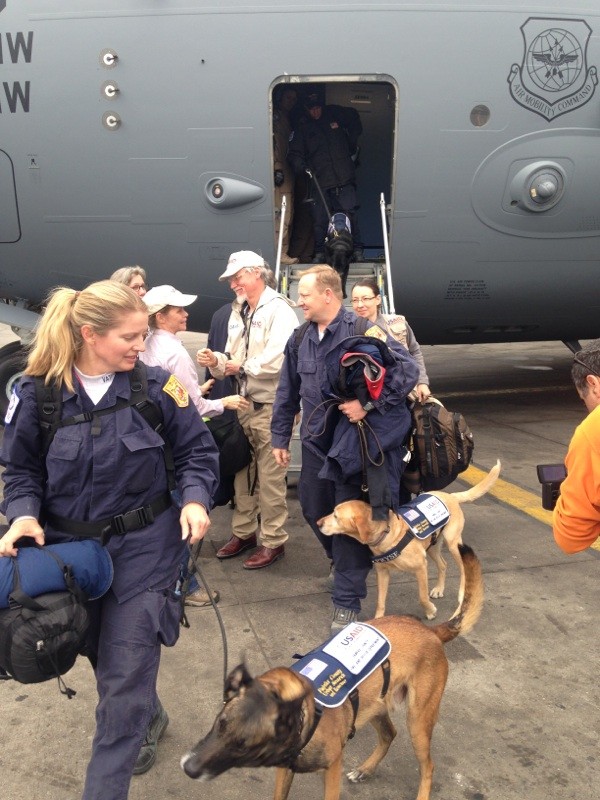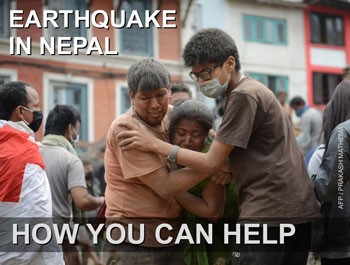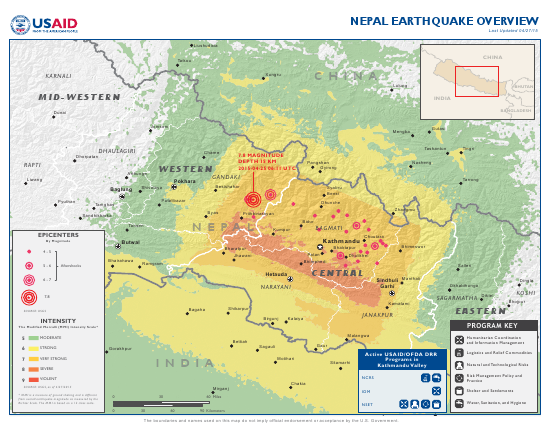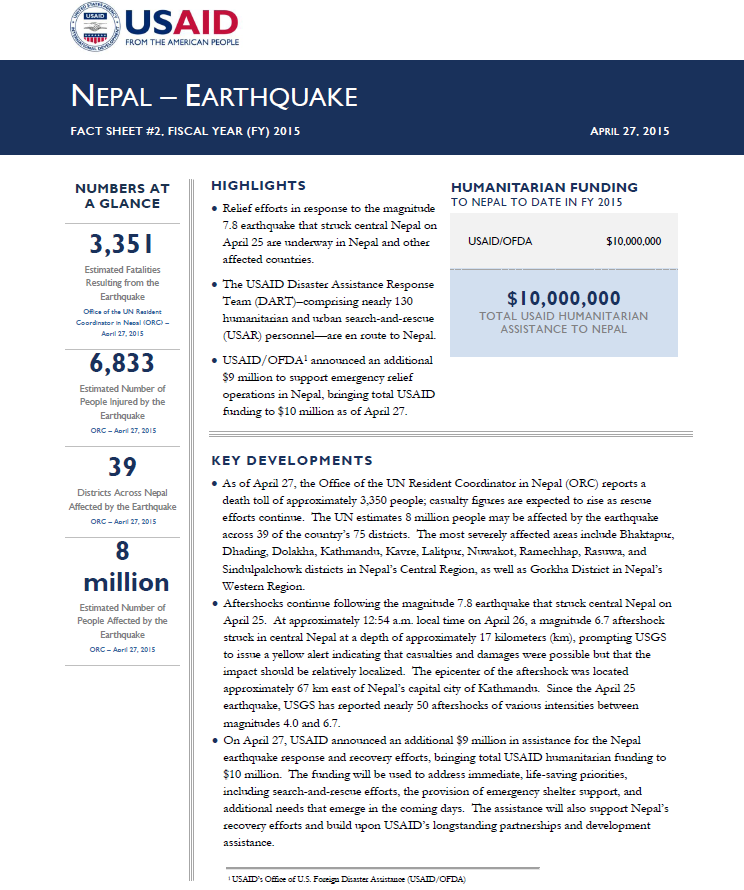April 27, 2015
Highlights
Relief efforts in response to the magnitude 7.8 earthquake that struck central Nepal on April 25 are underway in Nepal and other affected countries.
The USAID Disaster Assistance Response Team (DART)–comprising nearly 130 humanitarian and urban search-and-rescue (USAR) personnel—are en route to Nepal.
USAID/OFDA announced an additional $9 million to support emergency relief operations in Nepal, bringing total USAID funding to $10 million as of April 27.
Key Developments
Nepal Earthquake Map - April 27, 2015 ![]() (pdf - 1 MB)
(pdf - 1 MB)
Numbers At A Glance
3,351
6,833
39
8 million
Humanitarian Funding:
To Nepal To Date In FY2015:
| USAID/OFDA | $10,000,000 |
| TOTAL | $10,000,000 |
Nepal Earthquake Fact Sheet #2 - April 27, 2015 ![]() (pdf - 200k)
(pdf - 200k)
As of April 27, the Office of the UN Resident Coordinator in Nepal (ORC) reports a death toll of approximately 3,350 people; casualty figures are expected to rise as rescue efforts continue. The UN estimates 8 million people may be affected by the earthquake across 39 of the country’s 75 districts. The most severely affected areas include Bhaktapur, Dhading, Dolakha, Kathmandu, Kavre, Lalitpur, Nuwakot, Ramechhap, Rasuwa, and Sindulpalchowk districts in Nepal’s Central Region, as well as Gorkha District in Nepal’s Western Region.
Aftershocks continue following the magnitude 7.8 earthquake that struck central Nepal on April 25. At approximately 12:54 a.m. local time on April 26, a magnitude 6.7 aftershock struck in central Nepal at a depth of approximately 17 kilometers (km), prompting USGS to issue a yellow alert indicating that casualties and damages were possible but that the impact should be relatively localized. The epicenter of the aftershock was located approximately 67 km east of Nepal’s capital city of Kathmandu. Since the April 25 earthquake, USGS has reported nearly 50 aftershocks of various intensities between magnitudes 4.0 and 6.7.
On April 27, USAID announced an additional $9 million in assistance for the Nepal earthquake response and recovery efforts, bringing total USAID humanitarian funding to $10 million. The funding will be used to address immediate, life-saving priorities, including search-and-rescue efforts, the provision of emergency shelter support, and additional needs that emerge in the coming days. The assistance will also support Nepal’s recovery efforts and build upon USAID’s longstanding partnerships and development assistance.
CURRENT SITUATION – NEPAL
On April 26, the USGS issued an aftershock forecast, noting that three to 14 aftershocks of magnitude 5.0 or higher are anticipated during the coming week. The USGS also estimates a 54 percent chance of an aftershock of magnitude 6.0 or higher and a 7 percent chance of an aftershock at or exceeding magnitude 7.0 during the week of April 26. In the coming months and into 2016, USGS expects several aftershocks of magnitude 5.0 or higher, with a greater-than-50-percent chance of a magnitude 6.0 or stronger aftershock. Aftershocks to date have occurred in a zone extending up to 200 km away from the epicenter of the April 25 earthquake.
Initial evaluations from the Government of Nepal (GoN) and other sources indicate priority humanitarian needs of health and shelter assistance, the ORC reports. Critical medical item requirements include tents, medicines, and surgical kits, to ensure adequate support to treat those injured by the earthquake. Preliminary reports indicate that hospitals throughout Kathmandu Valley have become overcrowded and medical supplies are nearing depletion.
The GoN has identified 16 open spaces around Kathmandu to serve as displacement sites for earthquake-affected populations that have lost their homes, according to the ORC. The GoN has requested assistance from relief organizations to supply the sites. Many Nepalese in affected areas continue to sleep outdoors given the continued aftershocks, and most need tents and other shelter supplies.
The Food Security Cluster estimates that approximately 1.4 million people may require food assistance; the total includes 750,000 people residing in rural housing near the epicenter. The earthquake has disrupted preparations for the next planting season, which may affect Nepal’s food security situation in the coming months.
CURRENT SITUATION – REGIONWIDE
As of April 27, the earthquake had resulted in a death toll of 67 in India, according to the Government of India. The total includes 52 deaths in Bihar State, 12 in Uttar Pradesh, two in West Bengal, and one in Rajasthan. An additional nearly 300 people sustained injuries.
In Bangladesh, the earthquake and subsequent aftershocks has resulted in at least four deaths, with more than 200 people sustaining injuries, according to local and international reports. Several buildings, including multiple schools, were also damaged.
On Mt. Everest, the earthquake triggered an avalanche, resulting in at least 18 deaths and more than 60 injured people, according to international media. As of April 27, search-and-rescue teams had reportedly evacuated 140 people from the mountain before suspending rescue operations due to poor weather conditions.
Local Chinese media sources report at least 18 fatalities and more than 50 injured people due to the earthquake.
HUMANITARIAN COORDINATION
The Nepal Humanitarian Country Team (HCT)—comprising UN, international organization, and nongovernmental organization (NGO) representatives—has established coordination hubs in Kathmandu at the GoN National Emergency Operation Center, the UN office, and the humanitarian staging area at Tribhuvan International Airport. UN Disaster and Assessment Coordination (UNDAC) staff have also established a reception and departure center at the airport for the coordination of USAR teams and other humanitarian assistance, according to the ORC in Nepal. An OCHA team dispatched from Bangkok, Thailand, arrived on April 26 to help set up an on-site operations coordination center for search-and-rescue efforts.
The UN has activated its humanitarian cluster system—the sectoral coordinating mechanism for humanitarian activities, comprising U.N. agencies, non-governmental organizations (NGOs), and other stakeholders—and reports plans to launch an emergency flash appeal to support humanitarian relief efforts in Nepal.
With support from the UN World Health Organization (WHO), the GoN has activated a Health Emergency Operations Center to support coordination efforts. WHO has also provided emergency health kits to address the health needs of more than 40,000 people for three months and is deploying a 10-person emergency team, including disaster response and public health experts, to support GoN efforts to address health needs in affected areas.
On April 27, the International Federation of Red Cross and Red Crescent Societies (IFRC) launched an emergency funding appeal requesting approximately $35 million to support the Nepal Red Cross Society (NRCS) to respond to the humanitarian needs of 75,000 people in Nepal. In coordination with the NRCS, IFRC plans to provide health care, shelter, and livelihoods support, while also restoring family links, ensuring safe burials, and promoting preparedness and disaster risk reduction. IFRC also plans to deploy a 12-person field assessment and coordination team.
USG RESPONSE

USAID/OFDA has deployed a 128-person DART to support emergency response efforts in cooperation with the GoN. The team comprises 14 USAID/OFDA humanitarian specialists and 114 USAR personnel. USAID/OFDA also activated a Washington, D.C.-based Response Management Team (RMT) on April 25 to coordinate the USG response to the Nepal earthquake.
USAID committed an additional $9 million in assistance for the Nepal earthquake response and recovery efforts on April 27, bringing total USAID humanitarian funding to $10 million. The funding will be used to address immediate, life-saving priorities, including search-and-rescue efforts, the provision of emergency shelter support, and additional needs that emerge in the coming days. The assistance will also support Nepal’s recovery efforts and build upon USAID’s longstanding partnerships and development assistance.
INTERNATIONAL RESPONSE
The Government of India (GoI) has launched an extensive humanitarian relief and rescue operation—Operation Maitri—and deployed 10 National Disaster Response Force (NDRF) teams, comprising 450 people, to assist with emergency relief efforts in Nepal. The teams include 90 NDRF personnel internationally trained in search-and-rescue operations, local media report. According to Indian media sources, the GoI is preparing to deploy six additional NDRF teams to relief operations. The GoI has also deployed a team of medical professionals, an engineer task force to assist the GoN with power grid assessments, and has provided emergency relief commodities, including blankets, medicines, and safe drinking water, to support affected populations.
Initial relief supplies from the Government of Pakistan (GoP) arrived in Nepal on April 25, according to international media. As of April 27, the GoP had deployed search-and-rescue personnel and medical teams, and provided emergency relief supplies, including a 30-bed field hospital, blankets, medicine, safe drinking water, and shelter support, for the response.
A 62-member Government of the People’s Republic of China (GoPRC) search-and-rescue team arrived in Nepal on April 26, according to Chinese media sources. The GoPRC also announced plans to provide relief commodities valued at 20 million yuan, or approximately $3.2 million, to support response efforts.
On April 26, the Government of Australia (GoA) announced a contribution of 5 million Australian dollars—the equivalent of approximately $3.9 million—for life-saving humanitarian assistance in Nepal. The funding is expected to support activities by the Australian Red Cross, U.N. agencies, and Australian NGOs. The GoA has also deployed two humanitarian personnel to Nepal.
The Government of the UK (GoUK) has announced the deployment of an eight-person response team to Nepal; team members include search-and-rescue experts and medical personnel. The GoUK has also provided £5 million, or approximately $7.6 million, for response efforts.
PUBLIC DONATION INFORMATION
The most effective way people can assist relief efforts is by making cash contributions to humanitarian organizations that are conducting relief operations. A list of humanitarian organizations that are accepting cash donations for disaster responses around the world can be found at www.interaction.org.
USAID encourages cash donations because they allow aid professionals to procure the exact items needed (often in the affected region); reduce the burden on scarce resources (such as transportation routes, staff time, and warehouse space); can be transferred very quickly and without transportation costs; support the economy of the disaster-stricken region; and ensure culturally, dietary, and environmentally appropriate assistance.
More information can be found at:
- The Center for International Disaster Information: www.cidi.org or +1.202.821.1999.
-
Information on relief activities of the humanitarian community can be found at www.reliefweb.int.










Comment
Make a general inquiry or suggest an improvement.